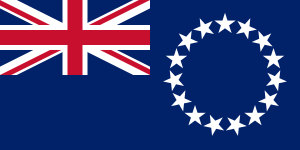1961 Cook Islands general election
General elections were held in the Cook Islands in May 1961.[1]
 |
|---|
| This article is part of a series on the politics and government of the Cook Islands |
Electoral system
The 27 members of the Legislative Assembly consisted of 15 directly elected members (14 from ten general constituencies and one from a European voter constituency),[2] seven members indirectly elected by Island Councils (four from Rarotonga and one from Aitutaki, Atiu and Mangaia),[2] and five officials members, including the Resident Commissioner as President of the Assembly, the Administration Secretary, the Treasurer and two members appointed by the Resident Commissioner.[2]
Results
| Constituency | Member | Notes |
|---|---|---|
| Aitutaki | William Estall | New member |
| Matai Simeona | New member | |
| Atiu | Vainerere Tangatapoto | Re-elected |
| Mangaia | Pokimo Aberahama | Previously Island Council representative |
| Manihiki | Ben Ellis Jnr | New member |
| Mauke | Terii Taripo | New member |
| Mitiaro | Tiki Tetava Ariki | |
| Penrhyn | Tangaroa Tangaroa | Re-elected |
| Puaikura | Ine Rutera | Re-elected |
| Rakahanga | Turura Temu | New member |
| Rarotonga | Dick Charles Brown | New member |
| Poko Ingram | New member | |
| Teupoko'ina Utanga Morgan | New member | |
| Teakura Roi | New member | |
| European | L.L. Bailey | New member |
| Aitutaki Island Council | Kau Mapu | Re-elected |
| Atiu Island Council | Parua Ariki | New member |
| Mangaia Island Council | Ngatupuna Matepi | Previously a directly-elected member |
| Rarotonga Island Council | Makea Nui Teremoana Ariki | Re-elected |
| Areora Ira | Re-elected | |
| Napa Tauei Napa | Previously a directly-elected member | |
| Teariki Tuavera | New member | |
| Source: Pacific Islands Monthly | ||
Appointed members
| Position | Member |
|---|---|
| Resident Commissioner | Oliver Dare |
| Chief Medical Officer | T.T. Romans |
| Director of Education | R.D. McEwan |
| Secretary to the Government | L.K. Pitt |
| Treasurer | T.N. Perry |
| Source: Pacific Islands Monthly | |
Aftermath
In 1962 an Executive Committee was established, with its members elected by the Assembly. It initially consisted of L.L. Bailey, Dick Charles Brown, William Estall, Ngatupuna Matepi, Vainerere Tangatapoto, Tangaroa Tangaroa and Teariki Tuavera, together with the Government Secretary and the Treasurer.[3]
By-elections in 1963 saw Dick Rapley elected to replace L.L. Bailey for the European seat (Bailey was also replaced on the Executive Committee by Napa Tauei Napa),[4][5] Julian Dashwood becoming the MLA for Mauke and David Marama Hosking becoming an MLA for Ratotonga,[6] replacing Teupoko'ina Morgan after she emigrated to New Zealand
In November 1963 the Executive Committee was revamped, becoming a "shadow cabinet" with defined portfolios.[4] Dick Charles Brown was elected the first Leader of Government business, defeating Ngatupuna Matepi by a vote of 11–10.[7] A new speaker was also appointed, with Teariki Tuavera defeating Ngatapuna Matepi in a secret ballot.[4]
| 1963 Executive Committee porfolios | |
|---|---|
| Portfolio | Member |
| Leader of Government Business | Dick Charles Brown |
| Deputy Leader | William Estall |
| Customs, Finance, Inland Revenue, Labour, Post Office, Radio, Shipping & Air, Treasury | |
| Agriculture, Co-operatives, Freezer, Hotel | Napa Tauei Napa |
| Broadcasting, Health, Justice, Police and Prisons, Social Development | Julian Dashwood |
| Education, Power, Printing, Public Works, Surveys | Tangaroa Tangaroa |
References
- Cook Is. Elections Bring Many New Faces Pacific Islands Monthly, June 1961, p21
- A Legislative Assembly Soon for Cooks Pacific Islands Monthly, September 1958, p139
- They'll work towards Self-government Pacific Islands Monthly, September 1962, p21
- Talks Soon On Political Future Of The Cooks Pacific Islands Monthly, January 1964, p35
- Pacific Islands Year Book 1963, p139
- David J. Stone Self rule in the Cook Islands: The government and politics of a new micro-state
- Speedy and Far-Reaching Changes In South Seas Political Scene Pacific Islands Monthly, December 1963, p7